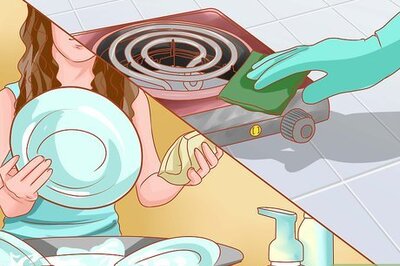
views
New Delhi: Many of us use credit cards, but only a few know its history and its existence. An informative piece on how and when people started the use of credit cards.
What is credit?
The word credit basically means giving someone time to pay. Whenever you sell something to another person and they promise to pay you back later, you are giving them credit.
In effect, you are loaning a sum of money, which will be repaid to you some time in the future. The word credit actually comes from Latin, the old Roman language.
The Roman word credere meant trust. In other words, when you sell something to another person but give them time to pay, you trust them to pay you back.
In many cases, the person loaning the money or giving credit will make a small charge - usually a percentage of the total - each month or each year until the money is repaid. This fee is called interest.
How long has credit existed?
Credit was first used by the ancient civilisations of Assyria, Babylon and Egypt around 3000 years ago. It spread to Europe as trade routes developed - putting people from these Arab lands in contact with Europeans - and really took off during the Middle Ages.
In the 12th century, large trading fairs were commonplace in Europe and people travelled from far and wide to buy and sell things. Traders went from one fair to the next, so credit was extremely important to them.
They use credit to buy things in one place and then get the money to pay for them in another by selling the goods at a profit. In Italy, trade agents were soon to be found at each large fair.
Their job was to record the details of this constant round process of buying, selling and repayment.
During this period, the idea of paying in instalments gained widespread acceptance.
However, it was a form of payment that was only available to people who could afford it.
Only those with a regular income could be confident of their ability to pay for things over a period of time. Such people were mostly traders - the growing middle class.
In 1730, a merchant called Christopher Thornton, who lived in Southwark, London, published an advertisement to attract customers.
It read 'rooms may be furnished with chests of drawers or looking glasses at any price, paying for them weekly, as we shall agree'.
Over 250 years later, you will find the same idea being used by all the large furniture retailers to encourage their customers to 'buy now and pay later'.
By the 14th century, the bill of exchange - the forerunner of modern banknotes - was established on the understanding that gold or silver was available at all times to cover its value.
PAGE_BREAK
Only in the 17th century did banks and governments begin to issue paper money with a greater face value than they had gold or silver to guarantee it.
When Britain changed during the 18th century from being a largely agricultural economy to a mainly industrial one, there was a great demand for new sources of credit.
This was required to help the new businesses of the Industrial Revolution to grow and expand. Credit became an important part of the economy.
Sellers put up with not being repaid for quite long periods of time. A London buyer did not repay the famous Wedgwood furniture firm for three years.
In part, this was because the banks changed very little interest - usually about two per cent per year.
Interest rates above five per cent were banned until 1832.
Cheques were not in general use until after around 1875. Before then, debts were settled by about one-third cash and two-thirds bill of exchange.
But the use of cheques increased quickly towards the end of the 19th century as the number of bank branches grew.
This made it easier to transfer money between traders in different parts of the country and increased people's use of the credit provided by the banks.
How did people use credit?
Until the end of the 19th century, only wealthy people had easy access to credit. Most people had to pay for things in cash.
If they did need to borrow money, people had to turn to moneylenders and pawnbrokers.
But this was often an unreliable form of credit, with high interest rates and often-difficult arrangements for repayment.
Other forms of credit were available to ordinary people but there was nothing like the network of banks and credit facilities, which we have today.
In local shops, it was possible for people to buy things on the slate or tab and pay for them on a monthly basis.
From the 18th century until the early part of the 20th, local tallymen or packmen travelled round selling clothes in return for small weekly payments.
These people were traders who allowed their customers to pay by installments. They were called 'tallymen' because they kept a record or tally of what people had bought on a wooden stick.
One side of the stick was marked with notches to represent the amount of debt and the other side was a record of payments.
They were called 'packmen' because they carried their goods (including Bibles and tea) on their backs.
During the 19th and early 20th centuries, as people became richer and had more money to spend on consumer durables and other items for the home, credit arrangements with shops became more commonplace.
Finance companies were formed in the late 19th century to meet this growing demand.
PAGE_BREAK
When did people start to use credit cards?
The forerunner of today's payment card was the 'shopper's plate', which was introduced in the USA in the 1920s.
In effect, it was an early version of the modern store card. It could only be used in the shops, which issued it, and it offered shoppers a basic form of credit - 'buy now, pay later'.
In this case, shoppers had to repay the money they owed in full every month. In the 1950s, Diners Club and American Express launched their charge cards in the USA.
These are the earliest examples of plastic money. Credit cards in the US soon followed.
Barclays Bank launched the first British credit card in 1966. It based Barclaycard on Bank Americard (now known as Visa).
It is only since the 1960s that credit has become widely available to most people and credit cards are one of the main reasons for this.




















Comments
0 comment